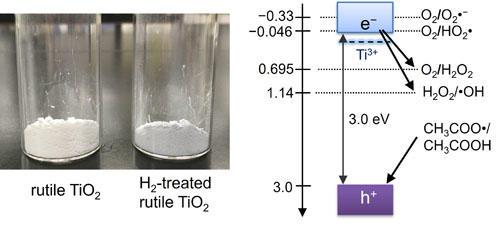
Highly Active Rutile TiO2 for Photocatalysis under Violet Light Irradiation at 405 nm
F. Amano, A. Yamamoto, J. Kumagai
Catalysts (MDPI), 12(10), 1079, 2022
https://doi.org/10.3390/catal12101079
Anatase TiO2 is a widely investigated photocatalyst; however, it can only work under ultraviolet (UV) light with wavelengths less than 390 nm (band gap 3.2 eV). Rutile TiO2 can absorb visible light at wavelengths less than 410 nm (band gap 3.0 eV); however, its photocatalytic activity is not high. Herein, we activated rutile TiO2, which was prepared from Evonik TiO2 P 25 through calcination at 800 °C using hydrogen reduction treatment at 700 °C. The photocatalytic activity of the hydrogen-treated TiO2 was as high as P 25 under UV irradiation at 380 nm, which was significantly higher than P 25 under violet light irradiation at 405 nm for the oxidative decomposition of acetic acid in water. Electron spin resonance studies indicate that charge separation is enhanced in reduced TiO2 and their oxygen reduction pathways differ between anatase and rutile. The formation of H2O2 was observed on rutile TiO2; however, it was consumed during photocatalysis to accelerate acetic acid decomposition.